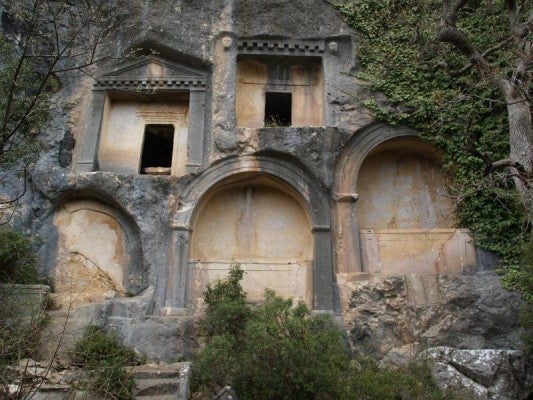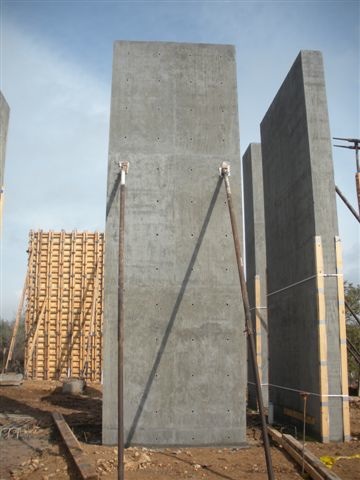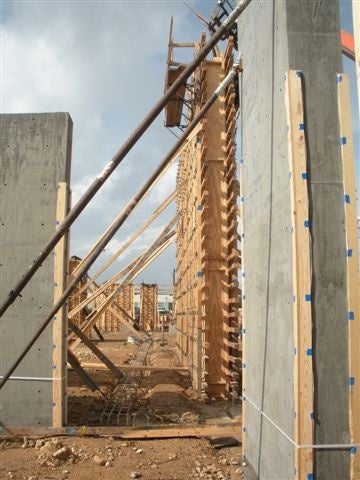
It is hot and humid as hell in most of Texas at the moment. The current conditions call into question whether our normal way of dealing with summer heat (using primarily insulation and air conditioning for cooling) is the only economical and ecological approach to these climate extremes.
I became interested using high thermal mass as an alternative while traveling in Turkey with my son Sloan eight years ago. He and I visited remote Roman ruins on the south coast and the interior, where the sites are in raw states and are not much frequented by tourists. The summer climate in Turkey is very hot and humid, not unlike Texas. But it was strikingly comfortable inside the stone ruins with their high thermal mass.
I noted the same effect working beautifully in the all-masonry city of Ping Yao in western China, where homes have thick, stone walls and massive, stone beds that kept us amazingly cool on hot summer nights.
 This is a classic heating and cooling technique in climates with high diurnal swing where the thermal mass dampens large fluctuations between hot days and cool nights. We have used rammed-earth walls effectively in places like Santa Fe to achieve this advantage.
This is a classic heating and cooling technique in climates with high diurnal swing where the thermal mass dampens large fluctuations between hot days and cool nights. We have used rammed-earth walls effectively in places like Santa Fe to achieve this advantage.
But when we used thick concrete walls for blast protection in a government office building in Houston, we also found that high mass could work to our thermal advantage. That building was pleasantly cool under construction before the air conditioning was turned on, and it made me wonder—why aren’t we doing more of this in Texas? Why is high insulation and air conditioning the only method of cooling?
Wiss, Janney, Elstner Associates, a renowned firm of building and forensic engineers, recently approached PageSoutherlandPage to design its one-story Austin office building, giving us a unique opportunity to thoroughly explore and analyze this question. WJE’s Austin office includes a bunch of the country’s best concrete experts. When we proposed using high thermal mass concrete walls for their building, they saw an interesting test case. They used a WUFI model to demonstrate how temperature would move through the thick concrete walls at all hours of the day and all times of year. They analyzed when the walls could produce thermal advantage as well as when dew point would be reached that might create condensation. In the end, the engineers convinced themselves and us it was worthwhile to proceed.
This had to be a pretty inexpensive building—a small office for a small business. Our budget was equivalent to a stud wall building with brick or stone veneer. The structural loads on the walls were modest and, of course, greater thickness worked to our thermal advantage. So we built unreinforced concrete walls—pure compression structures. The absence of rebar along with the fact that all of the formwork was kept to simple rectangles meant labor costs became low enough to be affordable. When we were pouring the walls, everyone said the finished pieces looked like Stonehenge.

This project is very experimental, but we have the engineers’ analysis to tell us how the material will behave. Architecturally, the concrete has a beautiful look and feel, which we didn’t fuss up at all. Though the air conditioning has not been activated and the temperature is approaching 100 degrees outside, the building interior is surprisingly cool.

Any links to an update on how this project turned out? I’m looking at building a home in Mexico that has a similar hot and humid climate and would like to use no air conditioning if at all possible. Deep porches, high ceilings, air convection stacking, cross ventilation and thermal mass are at the top of my list of things to discuss with the builder. This is in an area that is at the edge of almost yearly hurricane activity and the main building materials used for longevity purposes, are poured concrete and concrete block. Would be very interested in your findings regarding cooling effect once your project was completed. Thank you for your time.